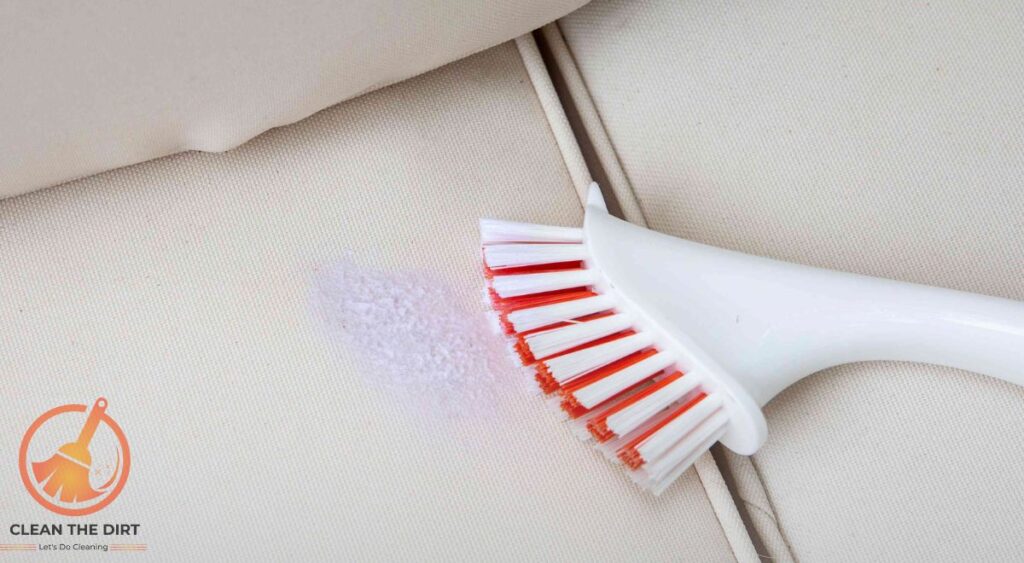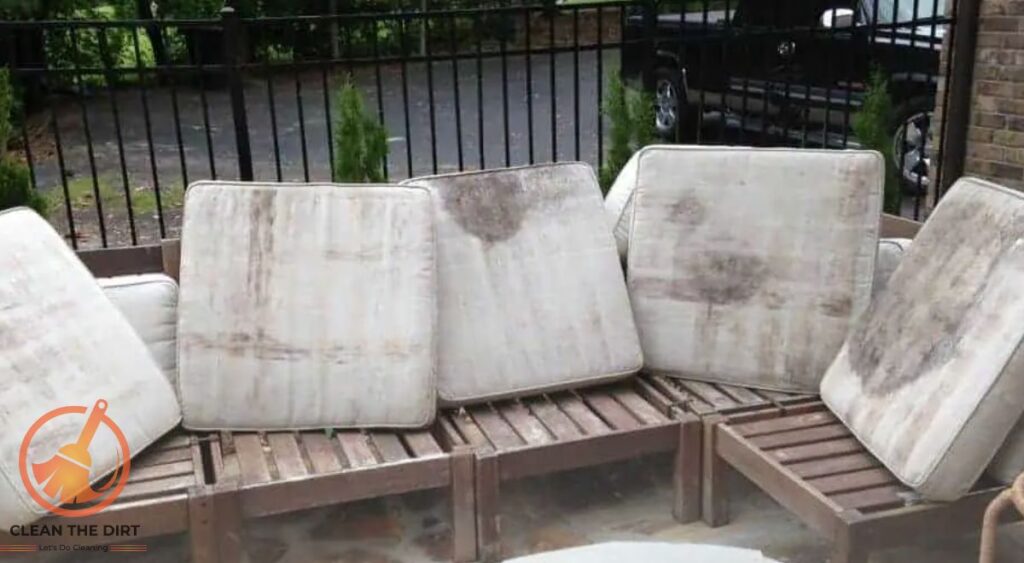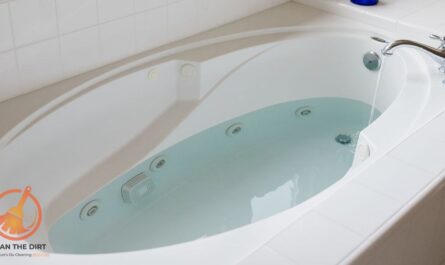Table of Contents
Introduction
Patio cushions are the perfect addition to any outdoor space, providing comfort and style. However, when exposed to the elements, they can become a breeding ground for mildew. Mildew not only looks unsightly but can also cause damage to the fabric, making your cushions less inviting. Knowing how to clean patio cushions with mildew is essential to maintaining a fresh and welcoming outdoor environment.
Whether your cushions are lightly sprinkled with mildew or overtaken by it, there are simple and effective methods to restore them. By following the right steps, you can remove mildew, protect your cushions, and extend their lifespan. In this guide, we’ll walk you through how to clean patio cushions with mildew using safe and reliable techniques that will leave your outdoor seating looking as good as new.
Why Mildew Forms on Patio Cushions?
Outdoor cushions are constantly exposed to the elements, which makes them prone to mildew. Mildew thrives in damp, warm environments, and your patio cushions can become the perfect breeding ground if they aren’t properly maintained. Understanding why mildew forms on your outdoor seating is crucial when learning how to clean patio cushions with mildew effectively.
1. Moisture and Humidity
Mildew is a type of fungus that develops when moisture is trapped in the fabric. This often happens after a heavy rain, when the cushions don’t have a chance to dry out completely. Additionally, high humidity levels and lack of direct sunlight can create the ideal conditions for mildew growth. If your patio cushions are stored in a shaded or poorly ventilated area, they’re even more susceptible to mildew.
2. Lack of Sunlight
Another contributing factor is the lack of direct sunlight. Cushions stored in shaded or poorly ventilated areas don’t dry out as quickly and can retain moisture longer. This prolonged dampness creates the perfect conditions for mildew to grow.
3. Fabric Type
Another factor that contributes to mildew formation is the type of fabric used in your patio cushions. Natural fibers, like cotton, tend to absorb moisture more easily than synthetic materials. However, even synthetic fabrics aren’t resistant if they aren’t properly cared for. That’s why knowing how to clean patio cushions with mildew is essential for maintaining their appearance and longevity.
By understanding the conditions that lead to mildew growth, you can take proactive steps to prevent it. Regularly cleaning and properly storing your cushions can go a long way in keeping them mildew-free. And if mildew does appear, following the right cleaning techniques will help you restore your cushions to their original state.
When maintaining your home and outdoor spaces, it’s helpful to have a variety of cleaning tips and techniques at your disposal. For instance, if you’re dealing with stubborn stains and grime in other areas, you might find our guides on how to clean toilet bowl stains without scrubbing and how to clean glass shower doors with hard water stains particularly useful. These methods can save you time and effort while keeping your spaces looking fresh and clean.
Materials You Will Need
Before you dive into how to clean patio cushions with mildew, it’s essential to gather the right materials. Having everything you require close at hand will facilitate a quicker and more effective procedure. You will need the following materials.
1. Mild Detergent
A mild detergent is key for cleaning patio cushions without causing damage. Choose a gentle soap that’s effective yet safe for the fabric. This will help lift mildew stains while protecting the cushion material.
2. White Vinegar or Baking Soda
White vinegar and baking soda are both excellent natural cleaners that can handle mildew. White vinegar has antifungal properties that can help kill mildew, while baking soda acts as a gentle abrasive that can help scrub away stains. Deciding which one to use will depend on your preference and the severity of the mildew.
3. Soft Brush or Sponge
A soft brush or sponge is necessary for scrubbing the cushions without damaging them. Choose a brush with soft bristles or a non-abrasive sponge to gently remove mildew from the fabric. This will help you effectively clean your cushions while preserving their texture.

4. Water
An essential component of cleaning is water. You’ll need it to dilute the detergent, vinegar, or baking soda, as well as to rinse the cushions thoroughly after cleaning. It helps in ensuring that all cleaning agents are properly removed.
5. Spray Bottle
A spray bottle is handy for applying your cleaning solution evenly across the surface of the cushions. It allows you to control the amount of cleaner you use and ensures that all areas are covered. This is especially useful when treating larger areas affected by mildew.
6. Protective Gloves
Protective gloves are important for keeping your hands safe from cleaning solutions and potential allergens. They also help to keep your hands clean and free from mildew residues while you work.
7. Commercial Mildew Remover (Optional)
If your cushions have a severe mildew problem, you might consider using a commercial mildew remover. These products are specifically designed to handle tough mildew stains and can be an effective solution if natural methods aren’t sufficient.
By gathering these materials, you’ll be well-prepared to handle the task of how to clean patio cushions with mildew. Having everything ready will make the cleaning process more straightforward and ensure that your cushions are restored to their best condition.
How to Clean Patio Cushions With Mildew? A Step-by-Step Guide
Cleaning mildew from your patio cushions doesn’t have to be a difficult task. With the right approach, you can effectively remove mildew and restore your cushions to their original condition. Here’s a step-by-step guide on how to clean patio cushions with mildew.
Step 1: Preparation
Starting with the cushions, take out any loose debris. Shake them out or use a vacuum with a brush attachment to get rid of dirt and leaves. Next, make sure the cleaning solution doesn’t stain the cushion by testing it on a little, discrete section of the cushion. This will help you avoid potential damage while cleaning.
Step 2: Apply the Cleaning Solution
Mix your cleaning solution according to the instructions. If you’re using a homemade solution, combine a few tablespoons of mild detergent with water, or create a mixture of white vinegar and water in a spray bottle. For a baking soda solution, dissolve a few tablespoons of baking soda in water. Spray the solution generously onto the affected areas of the cushion. Make sure to cover all areas with mildew for effective cleaning.
Step 3: Scrub the Cushions
Using a soft brush or sponge, gently scrub the cushion’s surface. Focus on areas with visible mildew, using circular motions to lift and remove the mildew. Refrain from applying excessive force since this can rip the fabric. If the mildew is particularly stubborn, let the cleaning solution sit for a few minutes before scrubbing.
Step 4: Rinse and Dry
After scrubbing, rinse the cushions thoroughly with clean water to remove all soap or vinegar residue. It’s important to ensure that all cleaning agents are washed away to prevent any potential damage or residue buildup. Once rinsed, gently squeeze out excess water from the cushions. Avoid wringing them, as this can distort the shape. Lay the cushions flat in a well-ventilated area or in direct sunlight to dry completely. Proper drying is crucial to prevent mildew from returning.
Step 5: Inspect and Repeat if Necessary
Once the cushions are dry, inspect them to ensure that all mildew has been removed. If any spots remain, you may need to repeat the cleaning process. For severe mildew cases, consider using a commercial mildew remover according to the manufacturer’s instructions.
By following these steps, you’ll have a thorough understanding of how to clean patio cushions with mildew and be able to effectively restore your cushions. Regular maintenance and prompt action can help keep your outdoor seating fresh and free of mildew in the future.
Additionally, if you’re handling different cleaning projects, like dusting off your ceiling or cleaning your hair brushes, you might want to check out our articles on how to clean dust off popcorn ceilings and how to clean hair brushes with vinegar and baking soda.
Preventing Mildew on Patio Cushions
Preventing mildew on your patio cushions is key to maintaining their appearance and extending their lifespan. While knowing how to clean patio cushions with mildew is important, taking proactive steps to prevent mildew can save you from dealing with the problem in the first place. Here are some practical tips to help you keep your cushions mildew-free.
1. Store Cushions Properly
When not in use, store your patio cushions in a dry, well-ventilated area. Avoid leaving them exposed to rain or high humidity. Using a storage box or cushion covers can help protect them from moisture and mildew. If possible, store cushions indoors or in a covered area to keep them dry and free from mildew-causing conditions.
2. Use Waterproof Covers
Invest in waterproof or water-resistant cushion covers. These covers act as a barrier against moisture, reducing the chances of mildew formation. Look for covers made from breathable materials that allow air circulation, which can help prevent the buildup of dampness and mildew.
3. Regular Cleaning
Regularly clean your patio cushions to prevent mildew buildup. Even if you don’t see visible signs of mildew, routine cleaning helps remove dirt, moisture, and other potential mildew sources. Knowing how to clean patio cushions with mildew will be easier if you make cleaning a part of your regular maintenance routine.
4. Ensure Proper Drying
After cleaning or exposure to moisture, ensure that your cushions dry completely before using or storing them. If your cushions get wet, place them in a sunny spot or a well-ventilated area to dry. Proper drying helps prevent mildew from taking hold and keeps your cushions in good condition.

5. Use Mildew-Resistant Products
Consider using mildew-resistant sprays or treatments designed for outdoor fabrics. These products can provide an extra layer of protection against mildew growth. Be sure to follow the manufacturer’s instructions for application to maximize their effectiveness.
6. Regularly Inspect Cushions
Perform regular inspections of your patio cushions to check for early signs of mildew. Catching and addressing potential issues early can prevent more extensive mildew problems. Knowing how to clean patio cushions with mildew and keeping an eye on your cushions can help you take action before mildew becomes a bigger issue.
By incorporating these preventative measures, you can effectively minimize the risk of mildew on your patio cushions. Regular maintenance and proper storage are key to keeping your outdoor seating fresh and inviting.
When to Replace Your Patio Cushions?
Even with the best efforts to prevent and clean mildew, there may come a time when your patio cushions are beyond saving. Understanding when to replace your cushions can save you from wasting time and effort on cleaning methods that may not work. Here’s how to determine if it’s time to replace your patio cushions, despite knowing how to clean patio cushions with mildew.
1. Severe Mildew Damage
If your cushions have extensive mildew damage that persists even after a thorough cleaning, it might be time to replace them. Severe mildew can penetrate deep into the fabric, making it difficult to remove completely. Despite your best efforts on how to clean patio cushions with mildew, some cushions may be too damaged to restore effectively.
2. Persistent Odors
A musty or unpleasant smell that lingers even after cleaning is another sign that replacement might be necessary. Mildew can leave behind stubborn odors that are challenging to eliminate, even with specialized cleaning techniques. If the smell persists despite knowing how to clean patio cushions with mildew, it may be time to invest in new cushions.
3. Fabric Damage
Over time, cushions can suffer from general damage, such as fraying edges or thinning fabric. If the structural integrity of your cushions is compromised, cleaning alone won’t restore their comfort or appearance. When you notice significant damage, replacing your cushions may be a more practical solution than trying to clean them.
4. Mold Growth
If mold has started to grow alongside the mildew, it can be particularly difficult to address. Mold can be more aggressive and harmful than mildew, often requiring specialized treatment or replacement of the affected items. Knowing how to clean patio cushions with mildew may not be sufficient if mold is present, as it indicates a more serious problem.
5. Overall Condition
Evaluate the overall condition of your cushions. If they are heavily stained, faded, or no longer provide the comfort and support they once did, it might be more cost-effective to replace them. Regular cleaning and maintenance are important, but sometimes the best option is to invest in new cushions to refresh your outdoor space.

Replacing patio cushions may seem like a big step, but it can ultimately enhance your outdoor comfort and enjoyment. While understanding how to clean patio cushions with mildew is valuable, recognizing when it’s time to replace them ensures that you maintain a clean, comfortable, and appealing outdoor area.
Conclusion
Keeping your patio cushions in top shape is essential for maintaining a welcoming and comfortable outdoor space. By understanding how to clean patio cushions with mildew, you can effectively handle and prevent mildew issues, ensuring your cushions remain fresh and inviting.
Remember, the key to managing mildew is regular maintenance and prompt action. Start by taking preventive measures, such as proper storage and using waterproof covers. If mildew does appear, follow the step-by-step guide on how to clean patio cushions with mildew to address the problem efficiently. Regular cleaning and proper drying will help extend the life of your cushions and keep them looking their best.
If you find that cleaning alone isn’t enough due to severe damage or persistent odors, don’t hesitate to consider replacement. Investing in new cushions can provide a fresh start and enhance your outdoor experience.
For more specialized tasks, such as deep-cleaning a jet tub or organizing a closet, our guides on how to clean a jet tub and how to clean a closet provide detailed steps to help you achieve a spotless result. Explore these resources for more effective cleaning solutions across your home.
Here’s a quick comparison of cleaning methods for patio cushions with mildew. The table below outlines each method’s effectiveness, pros, and cons to help you choose the best solution for your needs.
| Cleaning Method | Effectiveness | Pros | Cons | Best For |
|---|---|---|---|---|
| Mild Detergent + Water | Effective for light to moderate mildew | Safe for most fabrics; easy to use | May require multiple applications for tough mildew | Regular maintenance, light mildew |
| White Vinegar + Water | Effective for moderate mildew | Natural antifungal; removes odors | Strong smell during application | Moderate mildew, odor removal |
| Baking Soda + Water | Good for light to moderate mildew | Gentle abrasive; deodorizes | May not fully remove severe mildew | Light mildew, odor control |
| Commercial Mildew Remover | Highly effective | Formulated specifically for mildew; strong action | May contain harsh chemicals; follow instructions | Severe mildew or persistent issues |
| Bleach + Water | Very effective for severe mildew | Strong mildew-killing properties | Can damage fabric and cause color loss; harsh smell | Severe mildew (test fabric first) |
| Pressure Washing | Effective for external surfaces | Fast for large areas | Not recommended for cushions; can damage fabric | Large, durable outdoor items (not cushions) |
By combining effective cleaning techniques with preventative care, you can enjoy your patio cushions for years to come. Knowing how to clean patio cushions with mildew and taking proactive steps to prevent it will help you maintain a beautiful and comfortable outdoor space.
Frequently Asked Questions (FAQs) for How to Clean Patio Cushions With Mildew?
Can I use bleach to clean mildew off patio cushions?
Bleach can be effective at killing mildew, but it can also damage the fabric and affect the color of your cushions. It’s generally better to use milder solutions like white vinegar or a mixture of mild detergent and water. If you choose to use bleach, make sure to test it on a small area first and follow the manufacturer’s instructions carefully.
How often should I clean my patio cushions to prevent mildew?
Regular cleaning is key to preventing mildew. Aim to clean your patio cushions at least once a season or after exposure to significant moisture, such as after heavy rain. Regular inspections and prompt cleaning will help keep mildew at bay.
What if my patio cushions are too big to fit in my washing machine?
If your patio cushions are too large for your washing machine, you can clean them using a large tub or container. Fill the tub with a cleaning solution and use a soft brush or sponge to scrub the cushions. Rinse thoroughly with clean water and allow them to dry completely.
How can I prevent mildew from forming on my patio cushions?
To prevent mildew, store your cushions in a dry, well-ventilated area when not in use. Use waterproof or water-resistant covers, and ensure cushions dry completely after exposure to moisture. Regular cleaning and proper storage are essential for mildew prevention.
Can I use a pressure washer to clean mildew off my patio cushions?
While a pressure washer can be effective for cleaning outdoor surfaces, it’s not recommended for patio cushions as it can damage the fabric and seams. Stick to gentler cleaning methods like using a mild detergent and a soft brush or sponge to clean your cushions.
How do I know if my cushions need to be replaced rather than cleaned?
If your cushions have severe mildew damage, persistent odors, significant wear and tear, or mold growth, it might be time to replace them. While knowing how to clean patio cushions with mildew is important, some conditions may make replacement a more practical option.
You May Also Like: How to Clean Wool Rug? Preserve Softness and Vibrant Colors




